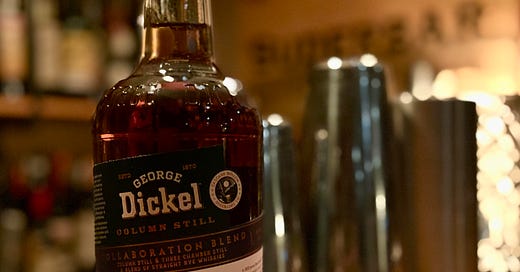Whiskey Wednesday: George Dickel x Leopold Bros. Collaboration Blend
A spicy, rich, incredibly tasty, historically inspired whiskey worth savoring.
In my introductory note to year two of this newsletter, I teased some forthcoming whiskey reviews. So this week I want to start with what I hope will become an occasional feature I’m going to call Whiskey Wednesday.
The goal here is not to be comprehensive about whiskey releases or to hit every high point in the whiskey world, nor to churn out a review every week.
Instead, I want to provide an occasional sketch of bottles that interest me and that I think might be of interest to readers as well. Some will be on the rare and pricey side, best suited for sipping neat. Some will be widely available bargains, best in cocktails or even on the rocks. I think there’s good whiskey at nearly every price point these days, and I don’t want to focus exclusively on expensive, hard to get bottles, though I’ll probably cover some bottles like that. Just to lay down a marker: I will never, ever review Pappy.
So for the inaugural installment, I figured I’d review something that sits in the middle ground between unobtainable and widely available: the new limited-edition collaboration blend between George Dickel, a venerable Tennessee producer of excellent whiskey, and the new Three Chamber Rye produced from Leopold Bros. in Colorado.
Let’s start with the Leopold Bros. Three Chamber Rye: It might be the most exciting whiskey release of 2021.
That’s because it was produced using a unique still — with, yes, three chambers — that hasn’t been seen in use for decades. Todd Leopold, the booze-maestro behind Leopold Bros. stumbled across pre-Prohibition diagrams for the still in some century-old tax documents, then convinced the still makers at Vendome Copper and Brass Works to put one together, not knowing for certain before fabrication that it would actually work. (There’s a great video explaining the still and its history, in which, among other things, Leopold talks about his habit of reading old manuscripts describing historic whiskey production methods.)
Well, it worked. Leopold filled the still with the Abuzzi rye, which was common historically but is rarely used today, and then barreled the distillate at an unusually low 100 proof rather than the typical barrel strength.
And after aging for several years, the initial batch was released over the summer. But supply was quite limited — just over 5,200 bottles — and at $250, the price was steep. (Where I live, retailers that still have bottles are charging more.)
Which brings us to this even newer release, which blends the pricey, unique Three Chamber Rye with another unique rye from George Dickel — a never-before-released column-still rye that was designed to mimic an old style of rye whiskey from Indiana. The column-still rye is lighter fruitier than the Three Chamber, and while the Dickel team hadn’t planned on releasing it because it didn’t quite achieve the flavor they were going for, according to The Daily Beast, they did agree to try blending it. The new collaboration bottle is the result.
Leopold’s Three Chamber Rye has won accolades from whiskey fans, but he argues that this blend is true to an original style. “When you look back at official records for Three Chamber Rye Whiskies, they weren’t just sold as is, but they were also blended together with column still whiskies,” he has said, sometimes pointing to depictions of three-chamber stills next to pot stils.
The resulting collaboration is a limited release, although it will likely be easier to find than the straight Three Chamber. And at $110 bottle, it’s definitely not cheap, but it’s considerably less expensive than a bottle of Three Chamber,.
But if you can find a bottle at retail price, it’s worth it. My whiskey tastings haven’t been comprehensive, but this is one of the better ryes I’ve ever tasted, with a profile that somehow feels both truly unique and also more intensely rye-like than most other bottles.
I always think it’s useful to taste whiskey (or any other spirit) alongside something else that might be at least somewhat comparable, in order to help understand the difference. In this case, I tasted the collaboration blend alongside a bottle of Leopold Bros. Maryland-style rye that I purchased earlier this year. The Maryland-style is interesting, but it’s also comparatively thin in body, and it has a barrel toasted note that is quite strong.
The collaboration blend, in contrast, is extremely creamy, both in taste and mouthfeel, with caramel notes and a hint of honey, as well as background notes of dried fruit and lavender. There’s a weightiness to it, both in flavor and in body, that’s unusual and quite pleasing. It’s also extremely spicy, with some of the wildest pepper notes I’ve ever tasted in a whiskey. And yet it’s not overpoweringly hot either. Instead, it’s just thick, flavorful, spiced, and exceptionally well balanced, almost like a little high-proof cocktail in your glass.
Part of the purpose of cocktails is to show off the spirits used to make the drink. But a spirit like this doesn’t need any accompaniment. I wouldn’t drink very much at a time — an ounce or two at most on an evening, ideally when it’s cold. This one is a luxury worth savoring.
***
(Thanks to the folks at Dickel & Leopold for providing a sample.)




After drinking (far) too much bourbon last night with friends, this is the last newsletter I needed to read... but... Have you tried the original Leopold edition, and if so, is it worth it? I can get a bottle at the local boutique liquor shop, and Christmas is coming up.
What happened to Whiskey Wednesday? Time to bring it back as the Fall gets into swing!